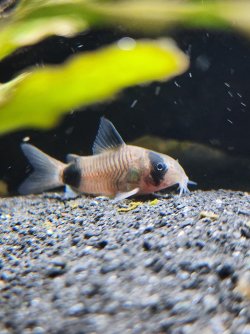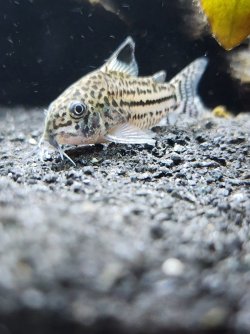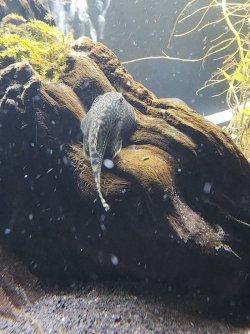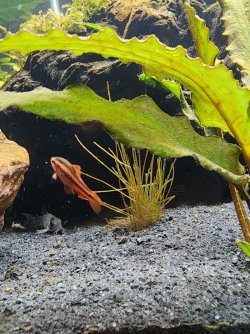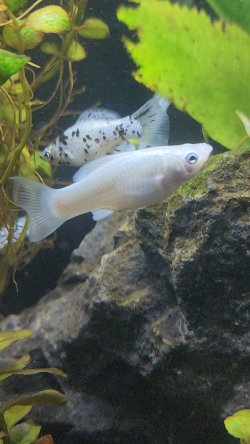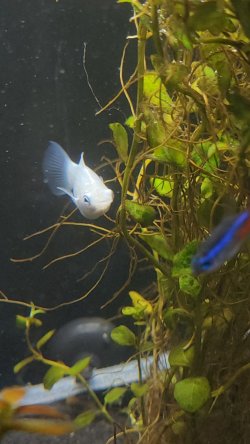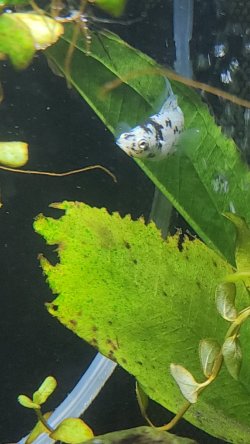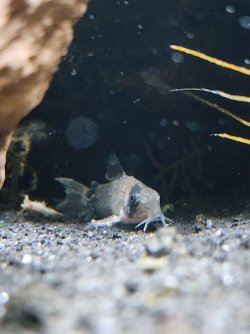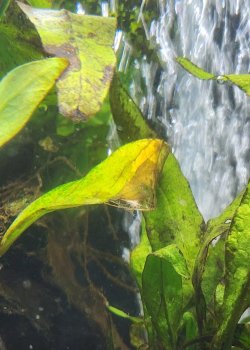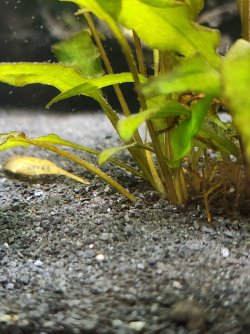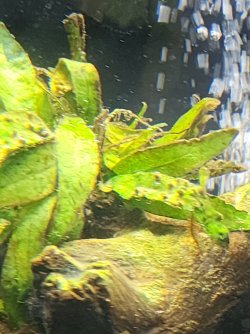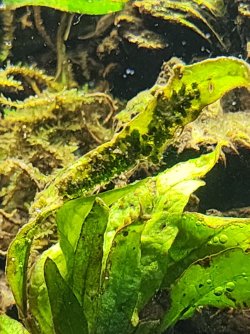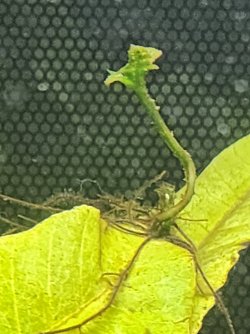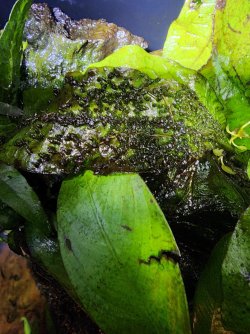armour72
New Member
Hi. I am new to forums and relatively new to fish keeping. I had a beta for 2 years and when he passed away last year, I decided to upgrade my tank and try new fish. His tank was a 5gal and I planned to turn it into a shrimp tank. I purchased 4 neon tetra, 1 Danio, and 1 blue neocaridina shrimp. I eventually added guppies. This tank is a healthy, cycled tank.
I listened to a George Farmer Podcast and learned that I should do a 50% water change every day for the first week, then every other day for a week, then once a week, and so on. I planned to follow this as closely as possible around my work schedule. I'm trying to be as detailed as I can be, so I apologize if I'm writing too much. I have well water. I purchased an Apera Instruments, LLC-A3719 PC60-Z (measures pH, conductivity, TDS, salinity, resistivity, temp). pH is around 8.4 from the tap, GH 5304 (30), KH 178 (10).
3/21/23--32.5g Fluval Flex initiated with Eco Complete, 30 Seachem root tabs, then topped with Flourite. The substrate is very thick. I didn't mean for that to happen. Then I added 2 air stones, live plants, lava rock, dragon stone, and driftwood.
3/22/23--50% water change. Added Seachem Advance, Prime, and Pristine. pH 8.73 found a Ramshorn snail from the plants and removed it.
3/23/23--50% water change. Added Advance, Prime, and Pristine. temp 78.3 pH 8.99 nitrite 0, ammonia 0.25, nitrate 0
3/24/23--50% water change. Added Advance, Prime, and Pristine. pH 8.13 temp 78.1
3/25/23--pH 8.75 temp 78.1 nitrite 0.25, ammonia 0, nitrate 5. I added driftwood with a java fern from my established tank to this new tank. Dosed with Flourish.
3/26/23--temp 78.9 nitrite 2, ammonia 0, nitrate 5
3/27/23--50% water change. Added Advance, Prime, Excel, and Pristine.
3/28/23--pH 8.59 temp 78.6 nitrite 0.2, ammonia, 0, nitrate 0. Added Prime, Pristine, Excel, and Flourish.
3/31/23--Tank pH 8.58 Tap water- ph8.49 temp 78.3 nitrite 0.25, ammonia 0, nitrate 5. MG 12.9ppm. CA 21.3 ppm, Copper 0.1, Lead 30, Chlorine 0.5, sulfate 400, total alk120
Found the first bladder snail. Removed it, didn't see any others (but have many more now).
4/1/23--Temp 78.1 nitrite 0, ammonia 0, nitrate 3
4/2/23--50% water change. Temp 78.2 nitrite 0, ammonia 0, nitrates 5. Added Stability, Advance, Prime, and Excel.
4/3/23-- Added Stability and Advance.
4/4/23-- Added Stability, Advance, and Excel. Temp 78.1
4/5/23 --Added my Danio from the original tank. Temp 78.3 pH 8.14 nitrite 0, ammonia 0, nitrate 0. Added Prime, Stability, and Stress Guard.
4/6/23--Temp 78.1 pH 8.33 nitrite 0, ammonia 0. nitrate 0. Moved the rest from the old tank--4 tetra, 1 hillstream loach, 1 blue neocaridina shrimp. Added Stress Guard, Stability, and Advance.
4/7/23-- Temp 78.1 pH8.23 nitrite 0, ammonia 0, nitrate 0. Purchased and added 2 Mollies, 1 Panda cory, and 2 more hillstream loaches.
4/8/23 --Added Stability and Stress Guard
4/9/23--Added Stability, Prime, Stress Guard, Excel, Flourish. Noticed plants are turning brown.
4/10/23--Temp 80.6 pH 8.2 nitrite 0, ammonia 0, nitrate 5. 50% water change. Added 4 guppies. Added Stability, Prime, Advance, Excel.
4/13/23--Fish store tested my water. Stated all levels were normal. She said I was safe to add the following: 4 Mollies, 3 panda cories, 2 julii cories, 1 yoyo loach, 5 cherry barbs. Added Stability, Prime, Stress Guard, Advance, Excel
4/14/23--pH 8.2 nitrite 0, ammonia 0, nitrates 0. Found new baby guppies!
4/15/23--pH 8.2 temp 80.4 nitrite 0, ammonia 0, nitrate 0. Added Stability, Stress Guard, Flourish, and Excel. Fed fresh boiled broccoli. Everyone ate it until the floret was gone.
4/16/23--Found 2 Mollies and 1 Panda cory dead. No wounds or markings. No rash/growth They looked like healthy fish. I unfortunately did not take a picture. Temp 78.6 pH 8.2 nitrite 0, ammonia 0, nitrate 0 O2 8mg/l 50% water change Added Prime and Stress Guard. One cherry barb color seems to be lightening.
4/17/23--Temp 78.6 pH 8.3 nitrite 0, ammonia 0, nitrate 3
4/18/23--Found 1 Molly, 1 Julii cory, and the yo yo loach dead in the morning. One panda moving slow. Has white patches on his body. He rubs his face in the substrate to get it off. Epistylis??? pH 8.2 nitrite
1, ammonia 1, nitrate 5. Did 30% water change. Tested one hour after water change: pH 8.2 nitrite 0, ammonia, 0, nitrate 2. O2 8mg/l. I added two more air stones. Added Prime and Stability. Noticed
one cherry barb's color is getting lighter. Local fish store told me it was ICH to put Paraguard in the water. I would have to do a fraction of a dose because loaches can be sensitive to the medication. I
was not comfortable treating when I wasn't sure what it was. I went to PetSmart and they told me to give API Fin and Body Cure (doxy). I was not comfortable with this either. I set up a hospital tank
and tried to catch the cory to put her in the tank but she vanished. I mixed doxy in the water and left the tank in case I decided to use it later.
4/19/23--No losses. temp 78.3 nitrite 0, ammonia 0, nitrate5. Did not feed today. Panda looks no different. I ended up putting 3ml of the ParaGuard into the tank @0815.
**We have 2 small local fish stores and a PetSmart and Petco. I am getting conflicting information from the two fish stores and what I read online. I stopped doing so many water changes because the fish store that I trust told me I was causing problems with my pH by doing this. This is also the store that told me my tank was ready for so many fish. The other fish store said he doesn't recommend salt and said the panda had a bacterial infection that should be treated with Kanaplex. He said to put it in their food. This confuses me. I have some fish that don't eat until later or get it from the floor. How do I know that all of the fish get an accurate dose of antibiotic if I'm just putting it in food that some will eat a ton and other won't eat at all? I'm attaching pictures below. Everything was going great until 4/16/23. Unfortunately I don't have any of those pictures.
Again, I'm sorry for being so lengthy. I'd welcome any advice or thoughts. Thank you very much for reading.
I listened to a George Farmer Podcast and learned that I should do a 50% water change every day for the first week, then every other day for a week, then once a week, and so on. I planned to follow this as closely as possible around my work schedule. I'm trying to be as detailed as I can be, so I apologize if I'm writing too much. I have well water. I purchased an Apera Instruments, LLC-A3719 PC60-Z (measures pH, conductivity, TDS, salinity, resistivity, temp). pH is around 8.4 from the tap, GH 5304 (30), KH 178 (10).
3/21/23--32.5g Fluval Flex initiated with Eco Complete, 30 Seachem root tabs, then topped with Flourite. The substrate is very thick. I didn't mean for that to happen. Then I added 2 air stones, live plants, lava rock, dragon stone, and driftwood.
3/22/23--50% water change. Added Seachem Advance, Prime, and Pristine. pH 8.73 found a Ramshorn snail from the plants and removed it.
3/23/23--50% water change. Added Advance, Prime, and Pristine. temp 78.3 pH 8.99 nitrite 0, ammonia 0.25, nitrate 0
3/24/23--50% water change. Added Advance, Prime, and Pristine. pH 8.13 temp 78.1
3/25/23--pH 8.75 temp 78.1 nitrite 0.25, ammonia 0, nitrate 5. I added driftwood with a java fern from my established tank to this new tank. Dosed with Flourish.
3/26/23--temp 78.9 nitrite 2, ammonia 0, nitrate 5
3/27/23--50% water change. Added Advance, Prime, Excel, and Pristine.
3/28/23--pH 8.59 temp 78.6 nitrite 0.2, ammonia, 0, nitrate 0. Added Prime, Pristine, Excel, and Flourish.
3/31/23--Tank pH 8.58 Tap water- ph8.49 temp 78.3 nitrite 0.25, ammonia 0, nitrate 5. MG 12.9ppm. CA 21.3 ppm, Copper 0.1, Lead 30, Chlorine 0.5, sulfate 400, total alk120
Found the first bladder snail. Removed it, didn't see any others (but have many more now).
4/1/23--Temp 78.1 nitrite 0, ammonia 0, nitrate 3
4/2/23--50% water change. Temp 78.2 nitrite 0, ammonia 0, nitrates 5. Added Stability, Advance, Prime, and Excel.
4/3/23-- Added Stability and Advance.
4/4/23-- Added Stability, Advance, and Excel. Temp 78.1
4/5/23 --Added my Danio from the original tank. Temp 78.3 pH 8.14 nitrite 0, ammonia 0, nitrate 0. Added Prime, Stability, and Stress Guard.
4/6/23--Temp 78.1 pH 8.33 nitrite 0, ammonia 0. nitrate 0. Moved the rest from the old tank--4 tetra, 1 hillstream loach, 1 blue neocaridina shrimp. Added Stress Guard, Stability, and Advance.
4/7/23-- Temp 78.1 pH8.23 nitrite 0, ammonia 0, nitrate 0. Purchased and added 2 Mollies, 1 Panda cory, and 2 more hillstream loaches.
4/8/23 --Added Stability and Stress Guard
4/9/23--Added Stability, Prime, Stress Guard, Excel, Flourish. Noticed plants are turning brown.
4/10/23--Temp 80.6 pH 8.2 nitrite 0, ammonia 0, nitrate 5. 50% water change. Added 4 guppies. Added Stability, Prime, Advance, Excel.
4/13/23--Fish store tested my water. Stated all levels were normal. She said I was safe to add the following: 4 Mollies, 3 panda cories, 2 julii cories, 1 yoyo loach, 5 cherry barbs. Added Stability, Prime, Stress Guard, Advance, Excel
4/14/23--pH 8.2 nitrite 0, ammonia 0, nitrates 0. Found new baby guppies!
4/15/23--pH 8.2 temp 80.4 nitrite 0, ammonia 0, nitrate 0. Added Stability, Stress Guard, Flourish, and Excel. Fed fresh boiled broccoli. Everyone ate it until the floret was gone.
4/16/23--Found 2 Mollies and 1 Panda cory dead. No wounds or markings. No rash/growth They looked like healthy fish. I unfortunately did not take a picture. Temp 78.6 pH 8.2 nitrite 0, ammonia 0, nitrate 0 O2 8mg/l 50% water change Added Prime and Stress Guard. One cherry barb color seems to be lightening.
4/17/23--Temp 78.6 pH 8.3 nitrite 0, ammonia 0, nitrate 3
4/18/23--Found 1 Molly, 1 Julii cory, and the yo yo loach dead in the morning. One panda moving slow. Has white patches on his body. He rubs his face in the substrate to get it off. Epistylis??? pH 8.2 nitrite
1, ammonia 1, nitrate 5. Did 30% water change. Tested one hour after water change: pH 8.2 nitrite 0, ammonia, 0, nitrate 2. O2 8mg/l. I added two more air stones. Added Prime and Stability. Noticed
one cherry barb's color is getting lighter. Local fish store told me it was ICH to put Paraguard in the water. I would have to do a fraction of a dose because loaches can be sensitive to the medication. I
was not comfortable treating when I wasn't sure what it was. I went to PetSmart and they told me to give API Fin and Body Cure (doxy). I was not comfortable with this either. I set up a hospital tank
and tried to catch the cory to put her in the tank but she vanished. I mixed doxy in the water and left the tank in case I decided to use it later.
4/19/23--No losses. temp 78.3 nitrite 0, ammonia 0, nitrate5. Did not feed today. Panda looks no different. I ended up putting 3ml of the ParaGuard into the tank @0815.
**We have 2 small local fish stores and a PetSmart and Petco. I am getting conflicting information from the two fish stores and what I read online. I stopped doing so many water changes because the fish store that I trust told me I was causing problems with my pH by doing this. This is also the store that told me my tank was ready for so many fish. The other fish store said he doesn't recommend salt and said the panda had a bacterial infection that should be treated with Kanaplex. He said to put it in their food. This confuses me. I have some fish that don't eat until later or get it from the floor. How do I know that all of the fish get an accurate dose of antibiotic if I'm just putting it in food that some will eat a ton and other won't eat at all? I'm attaching pictures below. Everything was going great until 4/16/23. Unfortunately I don't have any of those pictures.
Again, I'm sorry for being so lengthy. I'd welcome any advice or thoughts. Thank you very much for reading.
Attachments
-
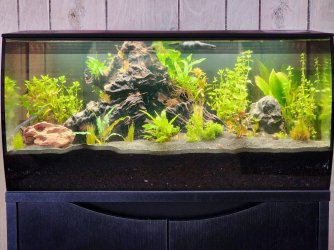 3-21-23 new 32.5 Flex.jpg400 KB · Views: 58
3-21-23 new 32.5 Flex.jpg400 KB · Views: 58 -
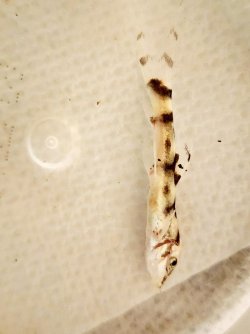 4-18-23 4.jpg155 KB · Views: 58
4-18-23 4.jpg155 KB · Views: 58 -
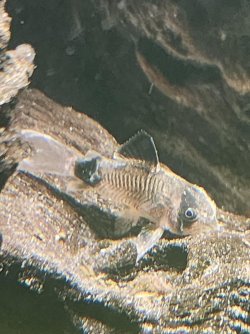 4-18-23-3.jpg251.7 KB · Views: 48
4-18-23-3.jpg251.7 KB · Views: 48 -
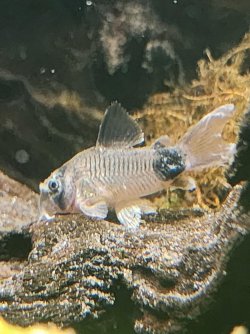 4-18-23-2.jpg262 KB · Views: 48
4-18-23-2.jpg262 KB · Views: 48 -
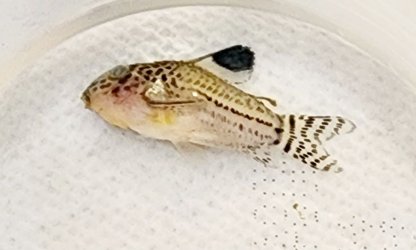 4-18-23.jpg52.4 KB · Views: 45
4-18-23.jpg52.4 KB · Views: 45 -
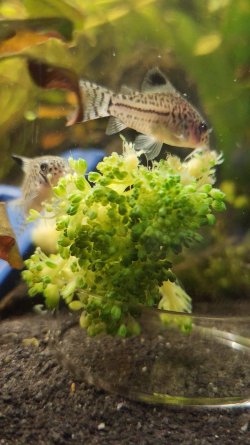 4-15-23.jpg224.7 KB · Views: 44
4-15-23.jpg224.7 KB · Views: 44 -
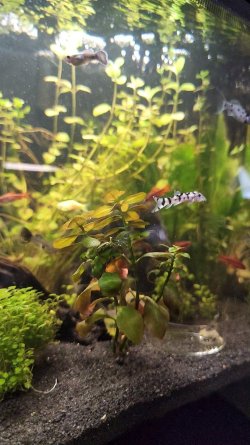 4-14-23.jpg238 KB · Views: 41
4-14-23.jpg238 KB · Views: 41 -
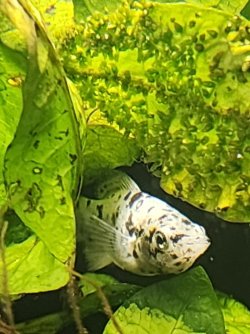 4-13-23.jpg232.5 KB · Views: 48
4-13-23.jpg232.5 KB · Views: 48 -
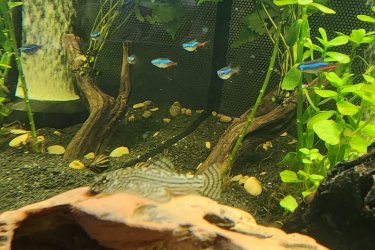 4-7-23.jpg301.5 KB · Views: 38
4-7-23.jpg301.5 KB · Views: 38 -
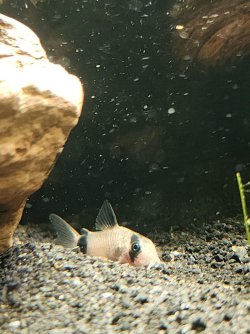 4-7-23 2.jpg278.3 KB · Views: 47
4-7-23 2.jpg278.3 KB · Views: 47



